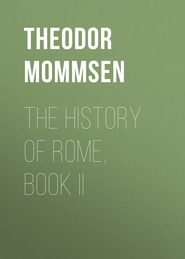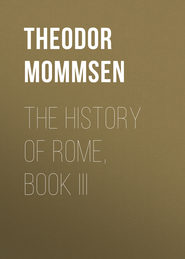По всем вопросам обращайтесь на: info@litportal.ru
(©) 2003-2024.
✖
The History of Rome, Book IV
Настройки чтения
Размер шрифта
Высота строк
Поля
236
That Sulla's assessment of the five years' arrears and of the war expenses levied on the communities of Asia (Appian, Mithr. 62 et al.) formed a standard for the future, is shown by the facts, that the distribution of Asia into forty districts is referred to Sulla (Cassiodor. Chron. 670) and that the Sullan apportionment was assumed as a basis in the case of subsequent imposts (Cic. pro Flacc. 14, 32), and by the further circumstance, that on occasion of building a fleet in 672 the sums applied for that purpose were deducted from the payment of tribute (-ex pecunia vectigali populo Romano-: Cic. Verr. l. i. 35, 89). Lastly, Cicero (ad Q. fr. i. i, ii, 33) directly says, that the Greeks "were not in a position of themselves to pay the tax imposed on them by Sulla without -publicani-."
237
III. XI. Separation of the Orders in the Theatre
238
IV. III. Insignia of the Equites. Tradition has not indeed informed us by whom that law was issued, which rendered it necessary that the earlier privilege should be renewed by the Roscian theatre-law of 687 (Becker-Friedlander, iv, 531); but under the circumstances the author of that law was undoubtedly Sulla.
239
IV. VI. Livius Drusus
240
IV. VII. Rejection of the Proposals for an Accomodation
241
III. XI. The Nobility in Possession of the Senate
242
How many quaestors had been hitherto chosen annually, is not known. In 487 the number stood at eight—two urban, two military, and four naval, quaestors (II. VII. Quaestors of the Fleet, II. VII. Intermediate Fuctionaries); to which there fell to be added the quaestors employed in the provinces (III. III. Provincial Praetors). For the naval quaestors at Ostia, Cales, and so forth were by no means discontinued, and the military quaestors could not be employed elsewhere, since in that case the consul, when he appeared as commander-in-chief, would have been without a quaestor. Now, as down to Sulla's time there were nine provinces, and moreover two quaestors were sent to Sicily, he may possibly have found as many as eighteen quaestors in existence. But as the number of the supreme magistrates of this period was considerably less than that of their functions (p. 120), and the difficulty thus arising was constantly remedied by extension of the term of office and other expedients, and as generally the tendency of the Roman government was to limit as much as possible the number of magistrates, there may have been more quaestorial functions than quaestors, and it may be even that at this period no quaestor at all was sent to small provinces such as Cilicia. Certainly however there were, already before Sulla's time, more than eight quaestors.
243
III. XI. The Censorship A Prop of the Nobility
244
We cannot strictly speak at all of a fixed number of senators. Though the censors before Sulla prepared on each occasion a list of 300 persons, there always fell to be added to this list those non- senators who filled a curule office between the time when the list was drawn up and the preparation of the next one; and after Sulla there were as many senators as there were surviving quaestorians But it may be probably assumed that Sulla meant to bring the senate up to 500 or 600 members; and this number results, if we assume that 20 new members, at an average age of 30, were admitted annually, and we estimate the average duration of the senatorial dignity at from 25 to 30 years. At a numerously attended sitting of the senate in Cicero's time 417 members were present.
245
II. III. The Senate. Its Composition
246
IV. VI. Political Projects of Marius
247
III. XI. Interference of the Community in War and Administration
248
IV. VII. Legislation of Sulla
249
II. III. Restrictions As to the Accumulation and the Reoccupation of Offices
250
IV. II. Attempts at Reform
251
To this the words of Lepidus in Sallust (Hist. i. 41, 11 Dietsch) refer: -populus Romanus excitus… iure agitandi-, to which Tacitus (Ann. iii. 27) alludes: -statim turbidis Lepidi rogationibus neque multo post tribunis reddita licentia quoquo vellent populum agitandi-. That the tribunes did not altogether lose the right of discussing matters with the people is shown by Cic. De Leg. iii. 4, 10 and more clearly by the -plebiscitum de Thermensibus-, which however in the opening formula also designates itself as issued -de senatus sententia-. That the consuls on the other hand could under the Sullan arrangements submit proposals to the people without a previous resolution of the senate, is shown not only by the silence of the authorities, but also by the course of the revolutions of 667 and 676, whose leaders for this very reason were not tribunes but consuls. Accordingly we find at this period consular laws upon secondary questions of administration, such as the corn law of 681, for which at other times we should have certainly found -plebiscita-.
252
II. III. Influence of the Elections
253
IV. II. Vote by Ballot
254
For this hypothesis there is no other proof, except that the Italian Celt-land was as decidedly not a province—in the sense in which the word signifies a definite district administered by a governor annually changed—in the earlier times, as it certainly was one in the time of Caesar (comp. Licin. p. 39; -data erat et Sullae provincia Gallia Cisalpina-).
The case is much the same with the advancement of the frontier; we know that formerly the Aesis, and in Caesar's time the Rubico, separated the Celtic land from Italy, but we do not know when the boundary was shifted. From the circumstance indeed, that Marcus Terentius Varro Lucullus as propraetor undertook a regulation of the frontier in the district between the Aesis and Rubico (Orelli, Inscr. 570), it has been inferred that that must still have been provincial land at least in the year after Lucullus' praetorship 679, since the propraetor had nothing to do on Italian soil. But it was only within the -pomerium- that every prolonged -imperium- ceased of itself; in Italy, on the other hand, such a prolonged -imperium- was even under Sulla's arrangement—though not regularly existing—at any rate allowable, and the office held by Lucullus was in any case an extraordinary one. But we are able moreover to show when and how Lucullus held such an office in this quarter. He was already before the Sullan reorganization in 672 active as commanding officer in this very district (p, 87), and was probably, just like Pompeius, furnished by Sulla with propraetorian powers; in this character he must have regulated the boundary in question in 672 or 673 (comp. Appian, i. 95). No inference therefore may be drawn from this inscription as to the legal position of North Italy, and least of all for the time after Sulla's dictatorship. On the other hand a remarkable hint is contained in the statement, that Sulla advanced the Roman -pomerium- (Seneca, de brev. vitae, 14; Dio, xliii. 50); which distinction was by Roman state-law only accorded to one who had advanced the bounds not of the empire, but of the city—that is, the bounds of Italy (i. 128).
255
As two quaestors were sent to Sicily, and one to each of the other provinces, and as moreover the two urban quaestors, the two attached to the consuls in conducting war, and the four quaestors of the fleet continued to subsist, nineteen magistrates were annually required for this office. The department of the twentieth quaestor cannot be ascertained.
256
The Italian confederacy was much older (II. VII. Italy and The Italians); but it was a league of states, not, like the Sullan Italy, a state-domain marked off as an unit within the Roman empire.
257
II. III. Complete Opening Up of Magistracies and Priesthoods
258
II. III. Combination of The Plebian Aristocracy and The Farmers against The Nobility
259
III. XIII. Religious Economy
260








